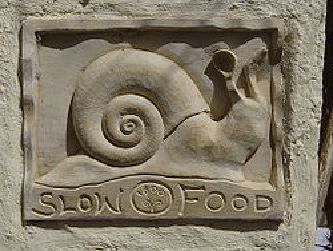Slow Food – Perfect for Hawaii
Marcel J. Hernandez, N.D.
 Before moving to Hawaii years ago, people told me how expensive it was to live here. Housing, food and imported basics, like toilet paper and rice drove the cost of living sky high. Yes, imported commodities are still costly and finding affordable housing continues to provide challenges, but eating extremely well can be much, much cheaper here than in most areas of the mainland. Before moving to Hawaii years ago, people told me how expensive it was to live here. Housing, food and imported basics, like toilet paper and rice drove the cost of living sky high. Yes, imported commodities are still costly and finding affordable housing continues to provide challenges, but eating extremely well can be much, much cheaper here than in most areas of the mainland.
The Slow Food movement was founded by Carlo Petrini in 1989 in Italy as a way of offering a functional, historically-based alternative to the spread of fast food, fast life and the disappearance of local food traditions. Petrini also hoped to reverse people’s waning interest in the food they eat, where it comes from, how it tastes and how our individual food choices impact the rest of the world. As part of its philosophy, slow food relies on preserving local ethnic and cultural cuisine by focusing on plants and seeds, domestic animals and farming produced within specific ecological regions.
In Hawaii, eating the Slow Food way applies to consuming not only to traditional Hawaiian food staples grown or raised right on the Island, but also applies to those tropical and semi-tropical foods brought through the immigrants from other parts of the warm world that have found a place in our Island food chain over the years. We are especially blessed with an abundance of produce, most of which grows year-‘round. Local farmers’ markets offer a dizzying variety of freshly-picked fruits and veggies, and fish and locally raised meats at prices often way below those found in local supermarkets.
Because the components of healthy nutrition vary among ethnic groups and from place to place, Slow Food is not a specific diet; rather, it is a way of living and a way of eating based on uniting the pleasure of whole foods with a commitment to the local community and the environment.
According to Wikipedia, the free on-line encyclopedia, the Slow Food movement incorporates a series of objectives within its mission, including:
"-- forming and sustaining seed banks to preserve heirloom varieties in cooperation with local food systems
-- developing an "Ark of Taste" for each ecoregion, where local culinary traditions and foods are celebrated
-- preserving and promoting local and traditional food products, along with their lore and preparation
-- organizing small-scale processing (including facilities for slaughtering and short run products)
-- organizing celebrations of local cuisine within regions (for example, the Feast of Fields held in some cities in Canada)
-- promoting "taste education"
-- educating consumers about the risks of fast food
-- educating citizens about the drawbacks of commercial agribusiness and factory farms
-- educating citizens about the risks of monoculture and reliance on too few genomes or varieties
-- developing various political programs to preserve family farms
-- lobbying for the inclusion of organic farming concerns within agricultural policy
-- lobbying against government funding of genetic engineering
-- lobbying against the use of pesticides
-- teaching gardening skills to students and prisoners
-- encouraging ethical buying in local marketplaces”
Slow Food has significantly contributed to the growing awareness of health concerns in Europe, where people are much more in tune with buying local, organic foods than they are in the USA. In its response to the billion-dollar fast food industry, Slow Food has focused on developing a strong presence in the schools. Community volunteers help establish school gardens and offer seminars to introduce students to the joys of farming.
The tenets of the Slow Food movement appear to be high-minded, but not everyone sees the movement as simply economical, healthy and environmentally conscious. Steven Shaw, a food writer and a founder of the food Web site eGullet, says the Slow Food movement has succeeded because it "mixed hedonism with a leftist political agenda". He further argues that the movement's "strong antitechnology, antiglobalization views are lost on the average member.”
If this is true, then Thomas Jefferson was a leftist when he put forth his vision of America as a “nation of small farmers.” I wonder what would have happened if we had chosen to follow his vision, instead of the Hamiltonian perspective of an America where social, cultural and environmental decisions were made on the basis of economics and finances.
Slow Food – check it out. It is the perfect answer for Hawaii residents to prosper and live well in difficult times.
Resources:
http://en.wikipedia.org/wiki/Slow_Food
http://www.slowfoodusa.org/
Graphic: A restaurant placard in Santorini, Greece, depicting the snail logo of the international Slow Food movement.
|



 Before moving to Hawaii years ago, people told me how expensive it was to live here. Housing, food and imported basics, like toilet paper and rice drove the cost of living sky high. Yes, imported commodities are still costly and finding affordable housing continues to provide challenges, but eating extremely well can be much, much cheaper here than in most areas of the mainland.
Before moving to Hawaii years ago, people told me how expensive it was to live here. Housing, food and imported basics, like toilet paper and rice drove the cost of living sky high. Yes, imported commodities are still costly and finding affordable housing continues to provide challenges, but eating extremely well can be much, much cheaper here than in most areas of the mainland.